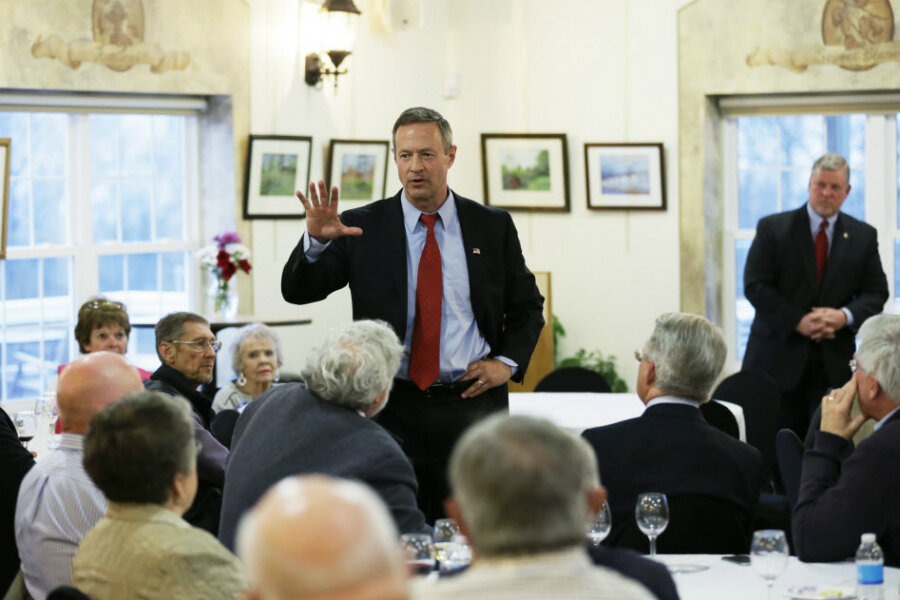Does anything about Martin O’Malley’s campaign make sense?
Loading...
| Washington
Poor Martin O’Malley.
The Democratic former governor of Maryland has been preparing to run for president for years. Literally. Even before the 2012 presidential election, Mr. O’Malley was dropping hints the size of the Chesapeake Bay that he was looking ahead to 2016.
But now that O’Malley’s announcement is upon us – 10 a.m. Saturday in Baltimore – he's almost become Rodney Dangerfield. He can’t seem to get much respect. He’s polling, on average, less than 1 percent among Democratic primary voters versus a whopping 63.6 percent for Hillary Clinton.
At the White House Correspondents’ Dinner last month, President Obama was merciless. He referenced Mrs. Clinton’s well-publicized effort to eat at a Chipotle incognito, then said this: "Not to be outdone, Martin O'Malley kicked things off by going completely unrecognized at a Martin O'Malley campaign event.”
Ouch. (Well, at least O’Malley got a mention.)
Even the smarty-pants at Crowdpac and the FiveThirtyEight blog have been dumping on O’Malley. The former Maryland governor has been trying to position himself to the left of Clinton, but that “makes no sense,” writes Harry Enten at FiveThirtyEight.
First, Clinton is already polling well among liberals, leaving not much room for O’Malley. Add to that the presence of Vermont Sen. Bernie Sanders (I), a self-described socialist, in the race, and O’Malley really gets squeezed.
But there’s another problem: O’Malley is actually less liberal than Clinton. FiveThirtyEight’s system shows him a fair bit to her right, based on fundraising data (i.e., no history of raising money on the left) and public statements. O’Malley is a “moderate liberal” on issues, to Clinton’s “hardcore liberal,” according to the ratings of OnTheIssues.org.
Crowdpac, a nonpartisan company that rates candidates, agrees that O’Malley is less liberal than Clinton, though its algorithm shows him to be just a little bit more conservative than her.
Then there’s Baltimore. Before serving two terms as governor of Maryland, O’Malley was twice elected mayor of Baltimore, and before that was a city councilman. He’s Mr. Baltimore. But Baltimore hasn’t had an easy go of it lately, and even though O’Malley left city government more than eight years ago, he’s had to answer for the city’s recent turmoil.
Still, instead of pretending he’s never heard of Baltimore, O’Malley is “hanging a lantern on his problem” – a time-honored political technique. His presidential launch from Baltimore seems to be an effort to turn the city’s problems to his advantage.
Even O’Malley’s two terms as a governor – résumé gold for a presidential candidate, one might think – aren’t seen as a big plus. He left office with job approval ratings in the low 40s, and his hand-picked successor – Lt. Gov. Anthony Brown (D) – failed to succeed him last November. The upset victory of Republican Larry Hogan in deep-blue Maryland was seen as a slap at O’Malley’s record, especially on taxes, and frustration over O’Malley’s presidential ambitions.
But despite it all, there are plenty of reasons for O’Malley to give the presidential thing a shot:
- He’s a first-time candidate, unlike Clinton. So he could benefit from Clinton fatigue.
- He looks presidential – especially in contrast to the perpetually rumpled Senator Sanders – and has a photogenic family. He also has a fun side, as a musician in a Celtic Rock Band called “O’Malley’s March.”
- There’s plenty of room for more Democratic contenders – especially compared with the Republican field, which is so crowded that only half will fit on the debate stage.
- Early polls aren’t 100 percent determinative. Even though Clinton appears to have a lock on the Democratic nomination, there are no guarantees.
- He has a rich record as governor on which to campaign. If O’Malley chooses to ditch the “more liberal than Hillary” approach, he could go back to his real persona as a technocrat. That may bring on images of 1988 Democratic nominee Michael Dukakis, whose demeanor left some voters cold. But O’Malley’s data-driven approach to government has won accolades and attention from around the world. Maybe he can make his geeky side chic.
- O’Malley could end up as Clinton’s running mate. Joe Biden, Al Gore, and George H.W. Bush all wound up on their party’s ticket after running unsuccessfully for the nomination. In Mr. Bush’s case, the vice presidency became a springboard to the presidency.
- And if O’Malley doesn’t make the ticket, he will still have boosted his national profile. That could help him toward another run in 2020 or 2024. O’Malley is only in his early 50s, so time is on his side.
There’s another piece of good news for O’Malley: Expectations about his chances in 2016 are so low he has nowhere to go but up. In the early nominating contests, he could beat expectations. And then he will face the real test: Can he pull together the money and organization to make a serious play for the nomination? It all starts on Saturday.






